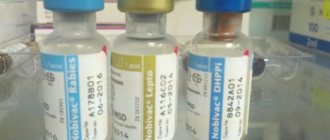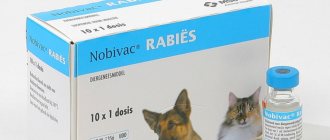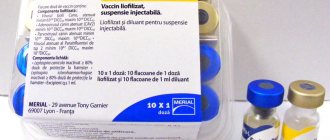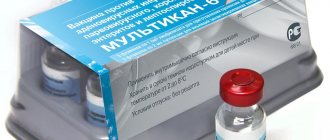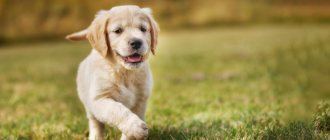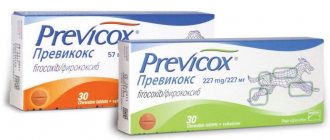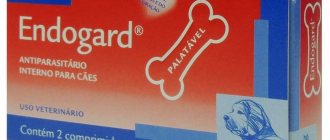The Nobivak vaccine is one of the most popular. It is widely distributed, in most cases well tolerated by animals and is reasonably priced. But there are reviews of severe adverse reactions to some batches of serum, including anaphylactic shock and death.
In this review, we’ll look at what types of Nobivak vaccines for dogs exist, how well they work, what scheme to use for vaccinating dogs, and what negative effects are possible.
At the end of the article you will find reviews from owners, answers to frequently asked questions and a list of analogues with prices.
Descriptions and prices are current as of November 2022 and are constantly updated.
What is Nobivak for dogs?
Comprehensive vaccination is a mandatory annual event for dogs and cats. The procedure is the best prevention against the most dangerous animal diseases of an infectious nature. In addition, leptospirosis and rabies pose a direct threat to humans.
Nobivak is a company that produces high-quality vaccines for dogs and cats. The company's employees are constantly developing more and more new drugs that protect pets from infectious pathologies. Nobivak is widely distributed throughout the world and is in great demand among veterinarians and animal breeders.
It is worth noting that no vaccine provides a complete guarantee that a pet will not become infected with the virus after vaccination. In addition, microorganisms mutate over the years, and new species appear that infect animals and cause serious health problems. However, in vaccinated animals the disease is mild and they have a greater chance of survival.
Is vaccination safe for my puppy?
Basic vaccinations such as DA2PP and rabies vaccine are considered safe for the vast majority of puppies. For these diseases, the benefits of the vaccine far outweigh the risks of contracting and killing them, and all dogs should have them as they protect against very serious diseases. Optional vaccines are also fairly safe, but if your pet has little chance of coming into contact with a disease, there is probably little need for such a vaccine.
Since the original dog vaccines were developed and licensed more than 50 years ago, efforts have continued to make them safer and more effective. Today it is generally accepted that canine vaccines have an excellent safety record.
However, vaccines are biological products and can cause adverse reactions and unpredictable side effects in dogs, regardless of age. However, most reactions are minor and easily controlled.
Regardless of age, if your dog is sick, vaccination may not be recommended. The idea of using vaccines is to stimulate the production of antibodies by a healthy immune system, so if this is compromised, the vaccine may not only be ineffective, but harmful.
Description
Vaccine for dogs (nasal drops) against bordetellosis and parainfluenza 1 dose + diluent.
The live dry vaccine against bordetellosis and canine parainfluenza in one dose contains at least 108 CFU of the attenuated pathogen Bordetella bronchiseptica strain B-C2 and 103 TCD50 of the causative agent of carnivorous parainfluenza strain Cornell, as well as stabilizers: hydrolyzed gelatin, pancreatic hydrolyzate of casein and sorbitol. A special solvent for vaccines, Nobivac Diluent, is a transparent sterile phosphate buffer with a pH of 7.2 - 7.4. In appearance, the vaccine is a homogeneous porous white mass. Nobivak KS is packaged in 1 dose, solvent - 0.4 ml in glass vials, hermetically sealed with polymer caps, rolled with aluminum caps and packaged in 1, 5 or 25 doses with the corresponding number of Nobivak Diluent bottles in a cardboard box with cells.
Release form, composition and packaging
International nonproprietary or chemical name: Animal rabies vaccine, inactivated
Developer: “Intervet International BV”, Wim de Korverstraat 35 PO Box 31 5830 AA Boxmeer, The Netherlands
Manufacturer: “Intervet International BV”, Wim de Korverstraat 35 PO Box 31 5830 AA Boxmeer, The Netherlands
Dosage form: suspension for injection
Qualitative composition and quantitative composition of active ingredients and qualitative composition of excipients: The vaccine contains the cultural liquid of a continuous cell line (BNK-21 clone CT), infected with a fixed rabies virus (strain “Pasteur RIV”), inactivated 6-propiolactone, adjuvant - phosphate aluminum and a buffer component - glycine.
Quantity in consumer packaging: 1 ml (1 dose) in bottles
Types of vaccine
Several types of vaccines are produced under the trade name nobivac:
Nobivac Lepto
Intended for vaccination of dogs against leptospirosis. The first vaccination is given when the puppy is two months old, followed by a booster vaccination two weeks later. Next, you need to vaccinate your dog every year. Immunity to the disease occurs three weeks after vaccination and is active for a year.
Nobivac Rabies
Designed for vaccinating pets against rabies. Puppies are given their first vaccination at the age of three months, then annually. Immunity begins to develop three weeks after administration and protects the dog from the virus for three years.
Nobivak RL
Designed for vaccinating dogs against leptospirosis and rabies. Recommended as a revaccination against leptospirosis and vaccination/booster vaccination against rabies. Primary administration is carried out at the age of three months, then annually.
Nobivac L4
Designed for vaccinating dogs against leptospirosis. A more modern and advanced drug than nobivac Lepto. Puppies are given their first vaccination at the age of 6 weeks, then revaccinated at 10 weeks. Subsequent vaccinations are given annually.
Nobivac PuppyDP
Designed for vaccinating pets against parvovirus enteritis and canine distemper. The first vaccination is given to puppies at the age of 1 month, then annually.
Intended for vaccinating dogs against infectious hepatitis, parvovirus enteritis, and canine distemper. The first vaccination is given at the age of 2 months, then once every three years.
Intended for vaccinating dogs against infectious hepatitis, parvovirus enteritis, and canine distemper. The first vaccination is given at the age of 2 months, then once every three years.
Nobivac DHP
Intended for vaccinating dogs against infectious hepatitis, parvovirus enteritis, and canine distemper. The first vaccination is given at the age of 2 months, then once every three years.
Nobivak dhppi
Intended for vaccinating pets against canine distemper, infectious hepatitis, parainfluenza, parvovirus enteritis. The first vaccination is given at the age of 2 months, the second a month later, then once annually.
Nobivak KS
Designed for vaccinating animals against bordetellosis and parainfluenza. It is administered as drops into the nose. The first vaccine is used at the age of 2 weeks, the second one a year later.
Why get vaccinated and is it necessary?
For many dog breeders, the question of the need for vaccinations remains a mystery. After all, animals in the wild can do without them and survive just fine.
And this is a big misconception:
- Firstly, dogs are already domesticated animals and their immunity is weaker than that of wild animals.
- Secondly, in the wild, the life expectancy of animals is much lower and they often die from infectious diseases.
- Well, thirdly, our favorite little animals do not live in the forest, where the danger of infection is much lower, but in a city where there is a lot of all kinds of chemical and natural waste, harmful emissions and other stuff. This means that the risk of getting infected in the city is much higher.
This is why the need for vaccination, in my opinion, is beyond any doubt. If the animal gets sick, the treatment will be very difficult and may even lead to the death of the dog. Therefore, it is better to vaccinate and prevent infection than to fight it.
Moreover, it is also necessary to vaccinate those animals that do not leave the apartment, since they can become infected even from their owner’s outdoor shoes or clothes.
Well, if you are going to take your animal with you when traveling by train or plane, then this question disappears altogether. Moreover, in the latter case, all vaccinations must be reflected in the veterinary passport and certified with the stamp of the state veterinary clinic.
How the vaccine works
To fight an infection, the body produces antibodies specific to a particular pathogen. It takes several days for the immune system to create them. When a second “meeting” with this infectious agent occurs, the immune system no longer wastes time identifying the pathogen, but starts the production of antibodies immediately, preventing the multiplication of the immunogen.
An inactivated vaccine is a preparation containing neutralized, non-viable viruses. They are not able to cause disease, but provoke the body to create means of defense against it. As a result of the Nobivak Rabies vaccine, the cat produces specific antibodies against the rabies virus, and if the animal comes into contact with the virus carrier, the body successfully copes with them, preventing the development of the disease.
Contraindications for use
Contraindications for the use of the drug are:
- diseases of the dog that lead to decreased immunity;
- weakened and exhausted state of the animal;
- damage by endo and exoparasites.
Sick and weakened individuals are exempt from the administration of such drugs.
Composition and description of the vaccine Nobivak Rabies
The rabies vaccine nobivac rabies is a suspension that contains inactivated, already killed virus rabies - rabies viruses.
In order for the body to intensively develop immunity to the substance, the vaccine contains an adjuvant.
It also includes some substances that help the body respond correctly to the injected serum.
Nobivac Rabies is made only from killed viruses. This eliminates even the slightest risk of infection with a weakened but live rabies virus. 1 package contains 10 bottles.
The appearance of the drug is a suspension, colored yellow or pink, of varying saturation. Supplied in transparent, glass bottles of 1 ml. The bottles are closed with rubber plugs and secured with aluminum tape.
Supplied in clear, glass bottles of 1 ml
Rules of application
Vaccination with the Nobivak Rabies vaccine is allowed for cats from the age of 3 months, provided that they are healthy. Unlike the Nobivac triquet trio vaccine, pregnancy is not a contraindication to the use of Nobivac Rabies. If, due to an unfavorable epizootic situation, such a vaccination was done earlier, it must be repeated when the animal reaches the age of 3 months. Scheduled revaccination is carried out once every 3 years.
About two weeks before your cat is scheduled to be vaccinated against rabies, be sure to deworm your pet. The helminthic infestation present in the animal’s body greatly reduces the effect of the vaccine and prevents the formation of active immunity.
The Nobivac Rabies vaccine is administered intramuscularly or subcutaneously. The procedure is carried out as follows:
- The bottle with the drug is shaken vigorously until a homogeneous emulsion is obtained.
- Having bent the center of the aluminum cap, wipe the rubber stopper with alcohol.
- Having pierced the stopper of the bottle with a needle, transfer its contents into a syringe.
- The injection site is treated with alcohol.
- After removing the air from the syringe, the drug is injected into a retracted skin fold on the neck or a muscle located under the knee.
- The cat is kept under observation for 10-15 minutes.
The rabies vaccine Nobivak Rabies can be used by mixing it in a syringe in a 1:1 ratio with the leptospirosis vaccine Nobivak Lepto. The use of Nobivac Rabies with the Nobivac Tricat trio vaccine against viral rhinotracheitis, calicivirosis and panleukopenia is permitted provided that they are administered with different syringes.
Instructions for use and dosage
It is recommended to vaccinate cats and dogs (as well as ferrets, foxes, raccoons, minks) from 3 months. The vaccine is administered subcutaneously or intramuscularly in an amount of 1 ml, which is 1 dose.
If for some reason the animal was vaccinated earlier, it is necessary to vaccinate the animal again at this age. Livestock (sheep, goats, horses, cattle) are vaccinated from 6 months.
1 dose of vaccine (1 ml) is administered intramuscularly.
If the animal was vaccinated before 6 months, then it is vaccinated again at 6 months of age.
Vaccination can only be given to healthy animals. Pregnant females can also be vaccinated with this vaccine. They are vaccinated intramuscularly.
If the owner wishes to vaccinate the animal himself, he must remember that:
- 10 days before vaccination (at least), the pet must be treated against parasites;
- after vaccination, do not wash for at least 10 days;
- in the coming days after vaccination (two weeks) do not change your diet;
- during the first vaccination, do not allow contact with other animals for 2 weeks (the entire quarantine period);
- You should take special care of your pet for 2 weeks - do not overload, do not tire, do not overcool.
During the first 3 days after vaccination, you should especially carefully monitor your pet's condition.
Before vaccination, the vaccine bottle must be warmed to the pet’s body temperature. This can be done under running hot water.
After the bottle is opened, it is administered immediately. The syringe used is only sterile. Disposable. After injection, the vial and syringe should be burned.
The injection site is not wiped with anything, so as not to disrupt the proper action of all strains of the vaccine.
Before vaccination, the vaccine bottle must be warmed to the pet’s body temperature.
Learn about essential drugs in animals
- Use of Dirofen in cats
- Vetoma for cats
- Instructions for using multifel in cats
- Instructions for use of fosprenil in cats
- Kotervin in cats
- Instructions for use Kot Bayun in cats
- Instructions for the use of feliferon in cats
- Stronghold in cats
- Instructions for use of Milbemax in cats
- Provides information about the drug gamavit
- Instructions for the use of spirovet in animals
- Instructions for use of tiamulin
- Instructions for use of Sevaxel in animals
- Instructions for use of thiam-oxy in animals
- Instructions for use of tetravet
- Application of TAF 25% in chickens
- Use of cefkinome in animals
- Instructions for the use of intramycin in animals
- Instructions for using inotil
- Instructions for use of cobactan in dogs
- Instructions for the use of coliside in animals. Calculate the optimal dose of the drug in birds, pigs, cows, sheep, goats
- Instructions for using Marbox for animals
- Instructions for the use of inosel in animals
- Instructions for using oxytetra in animals
^Top
Proposed vaccination schedule Nobivak RL
Depending on the local situation and the maternal immunity status of the animal, a choice may be made from the following vaccination programs:
- No direct risk of infection: 9 weeks of age Nobivac® Lepto and Nobivac® DHPPi. 12 weeks of age Nobivac® DHPPi and Nobivac® RL. In healthy dogs, this program will provide complete protection from all included components.
- Risk of parvovirus infection in weaned puppies. 9 weeks old Nobivac® DHPPi and Nobivac® Lepto. 12 weeks of age Nobivac® DHPPi and Nobivac® RL. The first vaccination after 9 weeks will protect 90% of puppies from parvovirus disease. The second vaccination will provide complete protection against all included components.
- Risk of parvovirus and plague infection. Age 6 weeks Nobivac® Puppy DP. 9 weeks old Nobivac® DHPPi and Nobivac® Lepto. 12 weeks old Nobivac® DHPPi and Nobivac® RL. The first vaccination after 6 weeks will provide protection against parvovirus disease in 75% of puppies, the second vaccination will increase this percentage to 95%, and the third vaccination will provide complete protection against all components.
Can I skip my puppy's next vaccination?
Vaccinations for puppies should be carried out on the schedule recommended by the veterinarian, and no major series should be skipped. The stickers and notes included in this series of vaccines are designed to prevent diseases that can be fatal to puppies or cause serious illness, so it is important to follow your veterinarian's advice when it comes to your puppy's vaccination schedule. Maternal antibodies disappear between 14 and 16 weeks of age and the reason for the vaccination series is to give the puppy protection against each disease as maternal antibodies weaken and disappear from the blood.
If you have concerns about the safety of any particular vaccine, or if your puppy has an allergic reaction to a vaccine, you should talk to your veterinarian about the risks and benefits of that particular shot for your puppy and decide where to go next.
People understandably have a mistrust of vaccines because there are so many of them. There are many factors that come into play... and it is imperative to take each individual into account when making these recommendations. Not all vaccines have the same composition, and not all are as effective as core vaccines or protect against diseases that are as common and serious.
For adult dogs, if you have concerns about routine administration of your next vaccine,
You can ask your veterinarian to perform a test to determine the titer of antibodies circulating in the blood. If antibody levels are protective, this vaccine can be safely skipped. Vaccine titer tests are available for canine distemper virus, canine parvovirus, canine adenovirus, and rabies virus, although high rabies vaccine titers cannot be legally recognized in lieu of vaccination status.
Repeated vaccination Nobivak RL
Rabies booster shots should be given every 3 years, but local regulations may require earlier booster shots. Revaccination against leptospirosis is necessary every year. It is recommended to vaccinate again against leptospirosis in the spring because Leptospira infections occur most often during late summer and to give dogs that are frequently exposed to natural water a third vaccination against leptospirosis 6 months after the main vaccination.
Revaccination – Annually against leptospirosis Nobivak® Lepto. Every 3 years Nobivac® RL anti-rabies (or sooner to comply with local regulations).
When to vaccinate your pet?
Vaccines are only effective after the puppy is weaned from its mother. Your veterinarian will tell you about the vaccines that are best for your dog, which depend on many factors, including where you live and how many other pets are in your home.
Most countries in the world require that all dogs be vaccinated against rabies. Be sure to keep evidence and records that your dog's vaccines were administered in a timely manner and of high quality, registered products.
Price and analogues
For home independent use, it is possible to purchase the drug individually in veterinary pharmacies.
The cost per vaccine will be approximately equal to:
- Lepto - 80 rub.
- Rabies - 110 rub.
- RL — 180 rub.
- L4 — 240 rub.
- Puppy DP — 240 rub.
- DHP - 270 rub.
- DHPPi — 270 rub.
- KS - 700 rub.
Analogues of the drug: eurikan and vanguard.
Eurikan
In the article I talked about the Nobivac vaccine for dogs, its composition, types and indications for use. I wrote how it works, what are the contraindications for use and side effects. She explained how the dosage is calculated and the drug is stored. She gave the price of the product and possible analogues.
